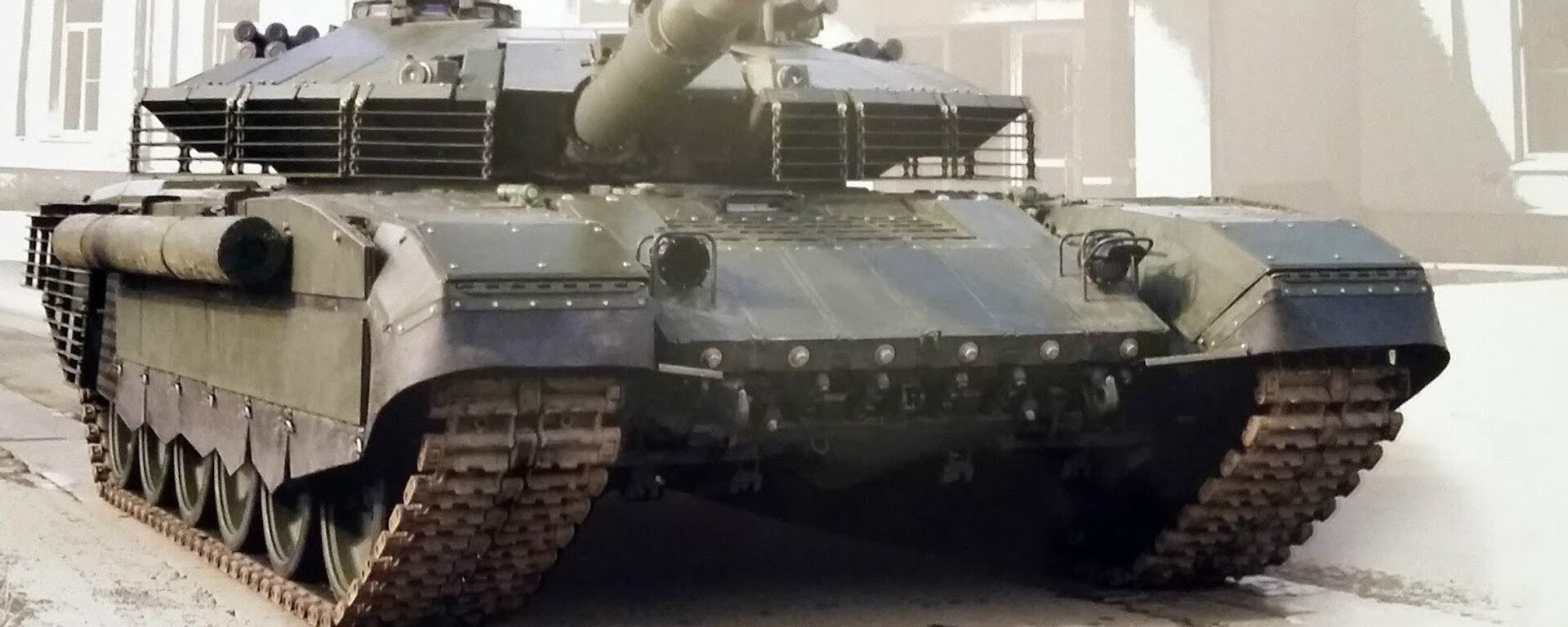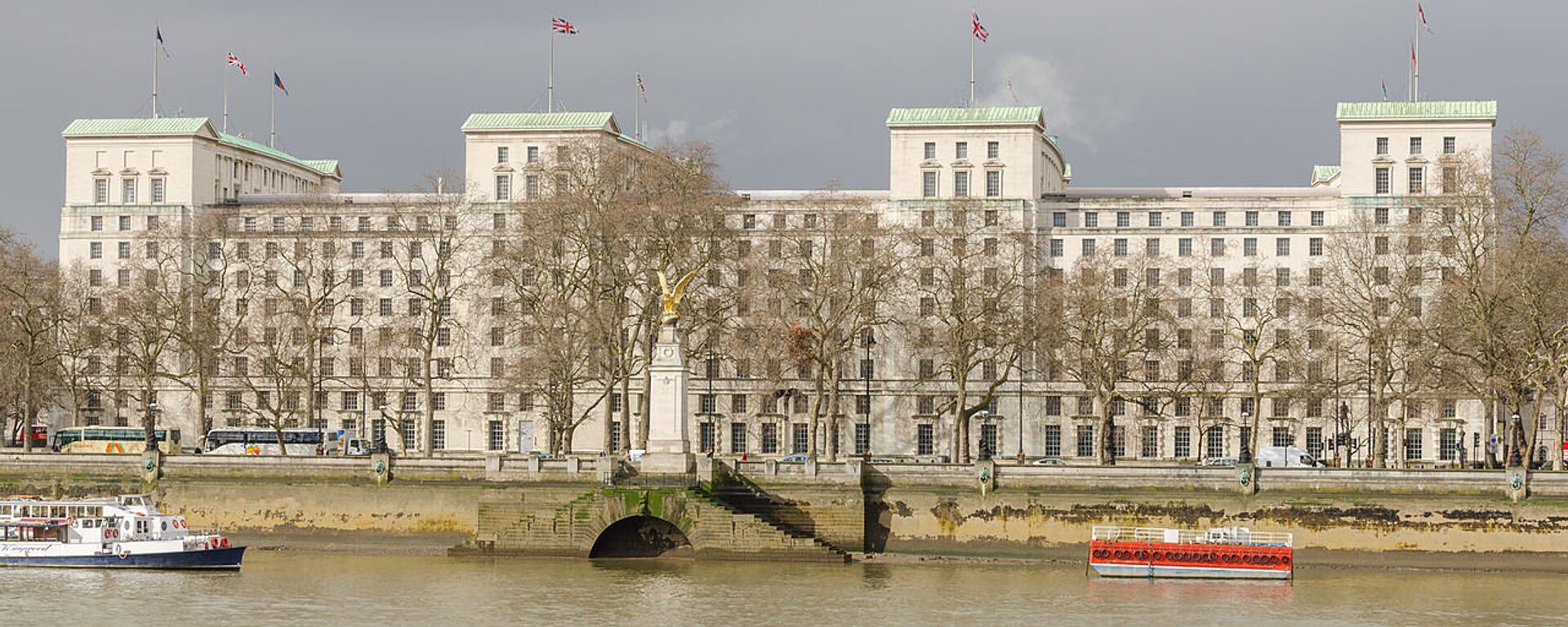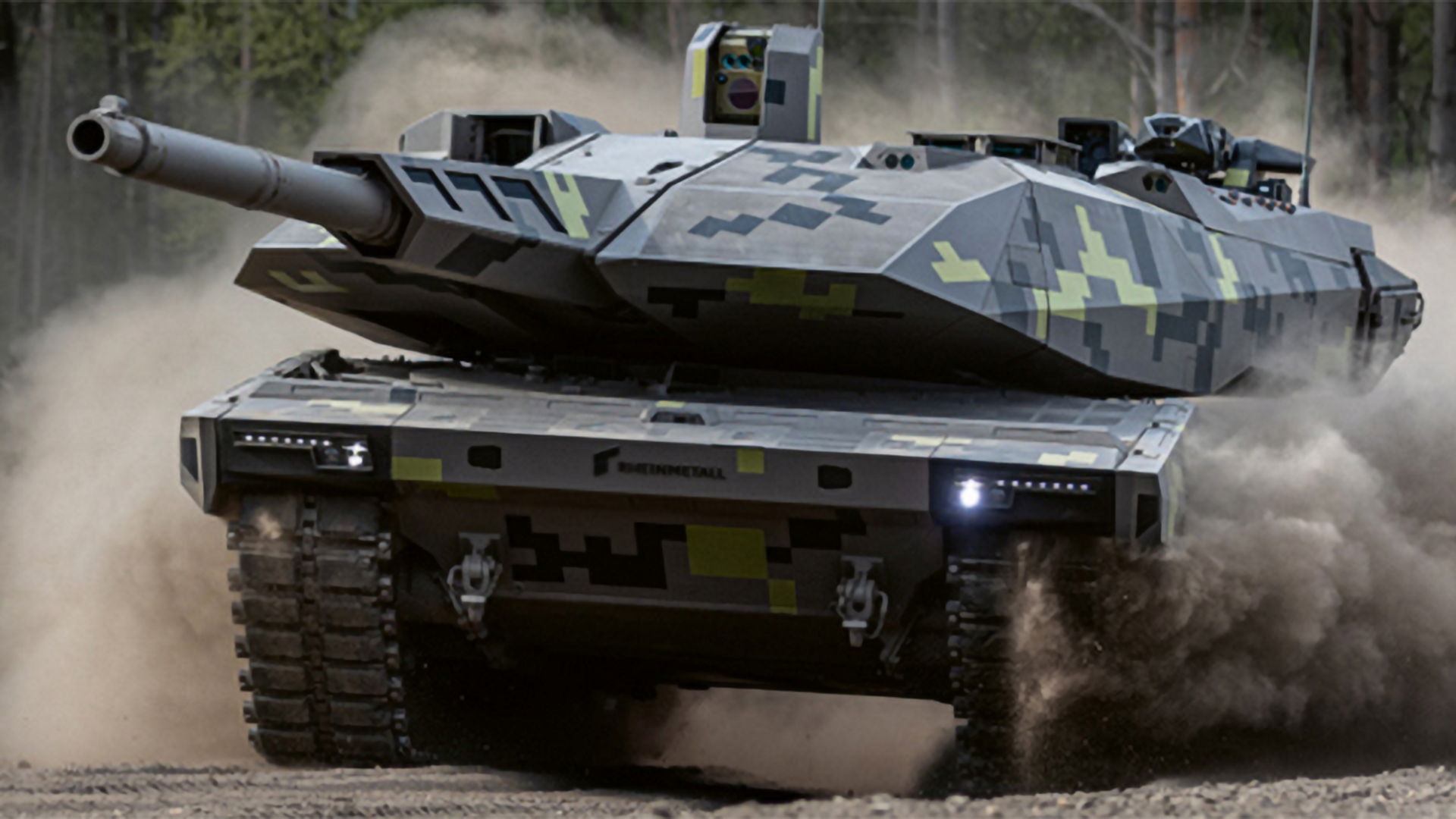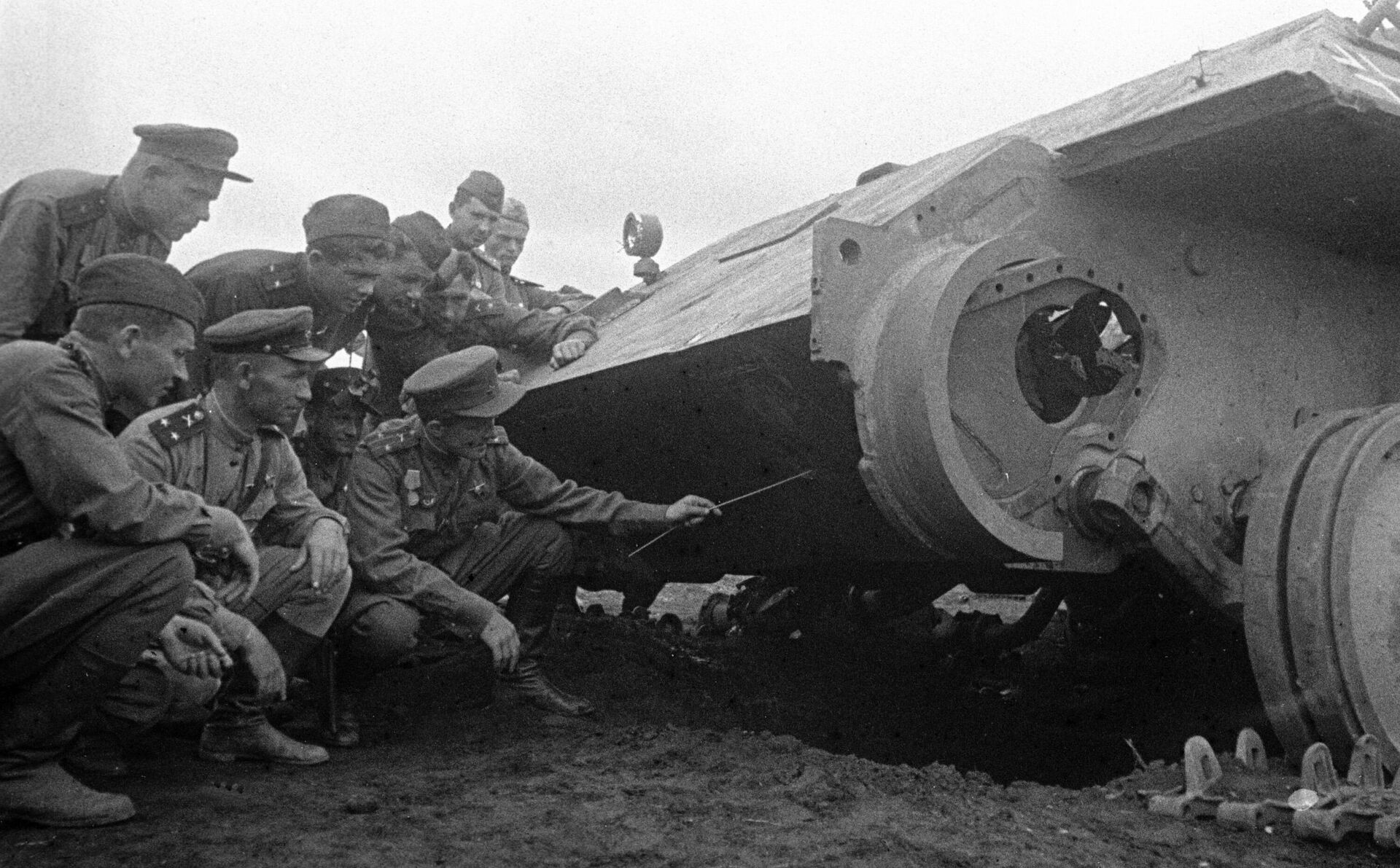https://sputnikglobe.com/20230213/germanys-panther-kf51-russian-tank-killing-wunderwaffe-or-roided-up-leopard-2-1107379234.html
Germany’s Panther KF51: Russian Tank-Killing Wunderwaffe or Roided Up Leopard 2?
Germany’s Panther KF51: Russian Tank-Killing Wunderwaffe or Roided Up Leopard 2?
Sputnik International
German weapons giant Rheinmetall wants to send its new Panther KF51 tank to Ukraine. What are the KF51’s characteristics, and how big a threat would they be to Russian tankmen? Sputnik explores.
2023-02-13T14:18+0000
2023-02-13T14:18+0000
2023-02-13T14:38+0000
military
panther
tank
anti-tank guided missile
tank crew
main battle tank
germany
rheinmetall
ukraine
russia
https://cdn1.img.sputnikglobe.com/img/07e7/02/0d/1107378225_0:0:1536:864_1920x0_80_0_0_2169e3da0ac579d79f652b0d1d8fc825.png
Rheinmetall chairman Armin Papperger told German media last week that his company is already “talking to Kiev” about the possible delivery of the company’s latest heavy tank - the Panther KF51, with production possible in as little as 15-18 months from now, pending approval from the German government.The Panther is one of about a dozen next-gen main battle tanks produced or in development by arms makers around the world, with a technology demonstrator unveiled just last June at the Eurosatory arms expo outside Paris.The tank’s main advertised feature is its massive 130mm main gun – a major upgrade to the Rheinmetall Rh-120, a 120 mm smoothbore fitted aboard the Leopard 2, the US M1 Abrams, Japan’s Type 90, and South Korea’s K1A1. Rheinmetall estimates that the eight percent increase in the caliber of the new gun will double the kinetic energy produced by the weapon, meaning shells – which weigh over 30 kg and measure over 1.3 meters long, will pack significantly more of a punch against enemy tanks, vehicles, buildings, and other targets. With its new main gun, the tank can lob shells up to 6,000-7,000 meters – double that of the Leopard 2’s 3,000-4,000-meter range.Spiritual Successor to a WWII DesignThe German habit of naming tanks after big cats goes back to the World War II, with the Panther’s KF51 WWII-era namesake, the Panzerkampfwagen V Panther, designed specifically to engage Soviet T-34 and KV-1s – which outclassed German medium tanks like the Panzer III and Panzer IV in terms of armor protection. Hitler’s generals hoped the Panther would reverse the increasingly dire situation on the Eastern Front following the Battle of Stalingrad. However, while the new tanks did prove effective against T-34s when first deployed at the Battle of Kursk in July of 1943, they failed to alter the battle’s outcome, or to turn the tide against the USSR. In addition, the tank’s 45-ton weight and advanced design resulted in a series of operational and logistical shortfalls, with issues like poor engine reliability, problems crossing Eastern Europe’s smaller bridges, lack of spare parts, and gas-guzzling fuel consumption souring its reputation.Like its modern-day equivalent, the original Panther featured an advanced and powerful main gun for its time – the Rheinmetall 7.5 cm KwK 42 L/70 anti-tank gun with armor-piercing rounds, and a cutting-edge electric semi-automatic firing mechanism. Weaknesses in the original Panther included its 40-50 mm thick side and 16 mm thick hull top armor, which made it vulnerable to everything from encroachment by enemy tanks to infantry wielding man-portable anti-tank weapons and grenades.New Life for Old PlatformNearly 80 years of time and at least four generations of tank design separate the original Panther from the KF51. Like their predecessors, engineers have sought to imbue the new tank with the offensive and defensive systems necessary for waging a modern-day land war in Europe (an idea which seemed unfathomable less than a decade ago). Unlike some next-gen tanks, such as the Korean K2 Black Panther or the Russian T-14 Armata, the KF51 cannot be said to be a truly new tank design. The tank features the same hull, engine, and transmission as a standard Leopard 2A4, the West German MBT produced between 1985 and 1992 at the twilight of the Cold War.Besides the heavy main gun, the Panther can deploy the HERO-120 loitering munition system, an Israeli-made series of small strike drones with a range of up to 40 km. Also present is a UAV reconnaissance quadrocopter designed for aerial reconnaissance of the battlefield. These drones may be effective against small militant groups armed with homemade weapons and little if any anti-drone protection, but their effect against a major regular army has yet to be demonstrated.A few other characteristics of the Panther are noteworthy, including its 500 km maximum range, its 59-ton weight, and its three-person crew (fourth crewmember optional). Its armor consists of Advanced Modular Armor Protection (AMAP) – a composite armor concept created by German armor maker IBD Deisenroth Engineering, and a TAPS (Top Attack Protection System) for use against incoming aerial projectiles.How Does the Panther Stack Up Against Russian Tanks?On paper, the PF51 outclasses all Russian tanks fielded in significant numbers, including the T-80 and T-90 MBT, their variants, and predecessors. This includes a more powerful main gun (the T-90 has a 125 mm smoothbore cannon with a 5,000-meter firing range), better armor, and superior (but potentially more finicky) fire control systems. Advantages of the Russian tanks include a smaller profile and lower production and maintenance costs, meaning more can be fielded for less money.Direct tank-to-tank comparisons aside, the real-world experience of Western MBTs in Iraq, Afghanistan and Syria over the last two decades has shown that a tank’s performance in battle depends on a host of factors – including fire support, commander competence, intelligence, and tank driver skill, which means even the most advanced wunderwaffe can be made vulnerable to the enemy – be it a conventional army or groups of shoeless and illiterate, but highly dedicated holy warriors.Combat experience of the Panther’s older cousin, the Leopard 2, has shown that any armor is killable – whether fighting militants in Afghanistan (who took out nearly two dozen Canadian and Danish Leopard 2s), or Islamist and Kurdish militias in Syria, where a dozen or more Leopard 2s operated by Turkiye were lost. In those conflicts, the enemy did not have access even to the latest anti-tank weapons, much less tanks.Like the Leopard 2 and other large NATO MBTs, the Panther has a serious potential weak point – a large gap between the chassis and turret which makes up about 20 percent of the frontal projection area. Past experience has found that a well-placed high-explosive fragmentation projectile piercing this spot can cause critical damage to the tank, or even rip its turret clean off.If Panthers are built and deployed to Ukraine, rest assured Russian forces will find a way to destroy them – whether by other tanks and anti-tank weapons, air-dropped bombs, or, if necessary, by super-heavy missiles. Or, as the case may be, the tanks could be destroyed before making it to the frontline – while on route to the battlefield aboard a train, for example.Perhaps this is Rheinmetall’s goal. Last month, Ukraine’s now former defense minister characterized his country as a “kind of combat testing” ground for NATO weaponry, while leaving out the heavy cost in Ukrainian lives and resources that this “testing” necessitates.Will the Tank Even See Fighting Ukraine?A lot can happen in the “15-18-month” period Papperger estimates it will take for a party of KF51s to be built for Ukraine. For one thing, Olaf Scholz’s government may not approve it. Late last month, the German chancellor expressed consternation over the idea of “a constant competition” amid NATO allies “to outbid each other when it comes to weapons systems” for Kiev.Training is another factor. While Germany approved Leopard 2 deliveries to Ukraine last month, the training of Ukrainian crews to use the German MBTs is expected to start only later this month, with deliveries of the tanks expected in late March or early April. The US, for its part, doesn’t plan to deliver its Abrams to the combat zone until late 2023 at the earliest, since the tanks, curiously, haven’t even been built yet.The Panther is a new tank that even Germany’s own ground forces haven’t seen, much less mastered. Notwithstanding pressure from Kiev, the Bundeswehr’s generals may be loath to send their most advanced MBT into combat in Ukraine, especially give the threat of Russia capturing them intact.How Many Panthers Can Germany Make?Between 1979 and 2015, Germany made roughly 3,600 Leopard 2s – approximately 100 tanks per year over 36 years. The vast majority were built during the Cold War, with production slowing to a crawl in the 1990s as Germany sold off its vast stocks to other countries.Accounting for the Panther’s use of a Leopard 2 chassis, Rheinmetall could be capable of producing 120-150 tanks per year. Even if all of this armor were immediately sent east to Kiev, given the present balance of forces, it wouldn’t be enough to alter the situation in the West’s favor.Russia’s military is already preparing for the appearance of Western tanks on the steppes of Ukraine. Last month, a Russian oil company offered a five-million-ruble reward for the destruction of the first Leopard 2 or Abrams, and 500,000 rubles for each subsequent tank destroyed. Separately, authorities in Russia’s Zabaykalsky region have promised to pay up to three million rubles for each captured Western MBT. What kind of bounty will be paid for the destruction or capture of a Panther is anyone’s guess.
https://sputnikglobe.com/20230207/russian-t-90m-tank-crews-and-uav-operators-train-in-rear-area-of-ukraine-op---video-1107036552.html
https://sputnikglobe.com/20230211/germany-to-reportedly-start-training-ukrainian-crews-to-operate-leopard-2-tanks-next-week--1107347239.html
https://sputnikglobe.com/20230129/uk-reportedly-wants-kiev-to-restrict-use-of-challenger-2-tanks-to-prevent-russia-from-capturing-1106802324.html
germany
ukraine
russia
Sputnik International
feedback@sputniknews.com
+74956456601
MIA „Rossiya Segodnya“
2023
News
en_EN
Sputnik International
feedback@sputniknews.com
+74956456601
MIA „Rossiya Segodnya“
Sputnik International
feedback@sputniknews.com
+74956456601
MIA „Rossiya Segodnya“
panther kf51, panther tank, main battle tank, tank, armor, ukraine, nato proxy war in ukraine
panther kf51, panther tank, main battle tank, tank, armor, ukraine, nato proxy war in ukraine
Germany’s Panther KF51: Russian Tank-Killing Wunderwaffe or Roided Up Leopard 2?
14:18 GMT 13.02.2023 (Updated: 14:38 GMT 13.02.2023) German weapons giant Rheinmetall wants to send its brand new Panther KF51 main battle tank to Ukraine. If deliveries proceed, the Panther would be the most advanced piece of NATO armor taking part in the West’s hybrid war against Russia. What are the KF51’s characteristics, and how big of a threat would they be to Russian tankmen? Sputnik explores.
Rheinmetall chairman Armin Papperger
told German media last week that his company is already “talking to Kiev” about the possible delivery of the company’s latest heavy tank - the Panther KF51, with production possible in as little as 15-18 months from now, pending approval from the German government.
The Panther is one of about a dozen next-gen main battle tanks produced or in development by arms makers around the world, with a technology demonstrator unveiled just last June at the Eurosatory arms expo outside Paris.
The tank’s main advertised feature is its
massive 130mm main gun – a major upgrade to the Rheinmetall Rh-120, a 120 mm smoothbore fitted aboard the Leopard 2, the US M1 Abrams, Japan’s Type 90, and South Korea’s K1A1. Rheinmetall estimates that the eight percent increase in the caliber of the new gun will double the kinetic energy produced by the weapon, meaning shells – which weigh over 30 kg and measure over 1.3 meters long, will pack significantly more of a punch against enemy tanks, vehicles, buildings, and other targets. With its new main gun, the tank can lob shells up to 6,000-7,000 meters – double that of the Leopard 2’s 3,000-4,000-meter range.
Spiritual Successor to a WWII Design
The German habit of naming tanks after big cats goes back to the World War II, with the Panther’s KF51 WWII-era namesake, the Panzerkampfwagen V Panther, designed specifically to engage Soviet T-34 and KV-1s – which outclassed German medium tanks like the Panzer III and Panzer IV in terms of armor protection. Hitler’s generals hoped the Panther would reverse the increasingly dire situation on the Eastern Front following the Battle of Stalingrad. However, while the new tanks did prove effective against T-34s when first deployed at the Battle of Kursk in July of 1943, they failed to alter the battle’s outcome, or to turn the tide against the USSR. In addition, the tank’s 45-ton weight and advanced design resulted in a series of operational and logistical shortfalls, with issues like poor engine reliability, problems crossing Eastern Europe’s smaller bridges, lack of spare parts, and gas-guzzling fuel consumption souring its reputation.
Like its modern-day equivalent, the original Panther featured an advanced and powerful main gun for its time – the Rheinmetall 7.5 cm KwK 42 L/70 anti-tank gun with armor-piercing rounds, and a cutting-edge electric semi-automatic firing mechanism. Weaknesses in the original Panther included its 40-50 mm thick side and 16 mm thick hull top armor, which made it vulnerable to everything from encroachment by enemy tanks to infantry wielding man-portable anti-tank weapons and grenades.
New Life for Old Platform
Nearly 80 years of time and at least four generations of tank design separate the original Panther from the KF51. Like their predecessors, engineers have sought to imbue the new tank with the offensive and defensive systems necessary for waging a modern-day land war in Europe (an idea which seemed unfathomable less than a decade ago). Unlike some next-gen tanks, such as the Korean K2 Black Panther or the Russian T-14 Armata, the KF51 cannot be said to be a truly new tank design. The tank features the same hull, engine, and transmission as a standard Leopard 2A4, the West German MBT produced between 1985 and 1992 at the twilight of the Cold War.
Besides the heavy main gun, the Panther can deploy the HERO-120 loitering munition system, an Israeli-made series of small strike drones with a range of up to 40 km. Also present is a UAV reconnaissance quadrocopter designed for aerial reconnaissance of the battlefield. These drones may be effective against small militant groups armed with homemade weapons and little if any anti-drone protection, but their effect against a major regular army has yet to be demonstrated.
A few other characteristics of the Panther are noteworthy, including its 500 km maximum range, its 59-ton weight, and its three-person crew (fourth crewmember optional). Its armor consists of Advanced Modular Armor Protection (AMAP) – a composite armor concept created by German armor maker IBD Deisenroth Engineering, and a TAPS (Top Attack Protection System) for use against incoming aerial projectiles.
How Does the Panther Stack Up Against Russian Tanks?
On paper, the PF51 outclasses all Russian tanks fielded in significant numbers, including the T-80 and T-90 MBT, their variants, and predecessors. This includes a more powerful main gun (the T-90 has a 125 mm smoothbore cannon with a 5,000-meter firing range), better armor, and superior (but potentially more finicky) fire control systems. Advantages of the Russian tanks include a smaller profile and lower production and maintenance costs, meaning more can be fielded for less money.
Direct tank-to-tank comparisons aside, the real-world experience of Western MBTs in Iraq, Afghanistan and Syria over the last two decades has shown that a tank’s performance in battle depends on a host of factors – including fire support, commander competence, intelligence, and tank driver skill, which means even the most advanced wunderwaffe can be made vulnerable to the enemy – be it a conventional army or groups of shoeless and illiterate, but highly dedicated holy warriors.

7 February 2023, 11:21 GMT
Combat experience of the Panther’s older cousin, the Leopard 2, has shown that any armor is killable – whether fighting militants in Afghanistan (who took out nearly two dozen Canadian and Danish Leopard 2s), or Islamist and Kurdish militias in Syria, where a dozen or more Leopard 2s operated by Turkiye were lost.
In those conflicts, the enemy did not have access even to the latest anti-tank weapons, much less tanks.
Like the Leopard 2 and other large NATO MBTs, the Panther has a serious potential weak point – a large gap between the chassis and turret which makes up about 20 percent of the frontal projection area. Past experience has found that a well-placed high-explosive fragmentation projectile piercing this spot can cause critical damage to the tank, or even rip its turret clean off.
If Panthers are built and deployed to Ukraine, rest assured Russian forces will find a way to destroy them – whether by other tanks and anti-tank weapons, air-dropped bombs, or, if necessary, by super-heavy missiles. Or, as the case may be, the tanks could be destroyed before making it to the frontline – while on route to the battlefield aboard a train, for example.

11 February 2023, 21:53 GMT
Perhaps this is Rheinmetall’s goal. Last month, Ukraine’s now former defense minister characterized his country as a
“kind of combat testing” ground for NATO weaponry, while leaving out the heavy cost in Ukrainian lives and resources that this “testing” necessitates.
Will the Tank Even See Fighting Ukraine?
A lot can happen in the “15-18-month” period Papperger estimates it will take for a party of KF51s to be built for Ukraine. For one thing, Olaf Scholz’s government may not approve it. Late last month, the German chancellor
expressed consternation over the idea of “a constant competition” amid NATO allies “to outbid each other when it comes to weapons systems” for Kiev.
Training is another factor. While Germany approved Leopard 2 deliveries to Ukraine last month, the training of Ukrainian crews to use the German MBTs is expected to start
only later this month, with deliveries of the tanks expected in late March or early April. The US, for its part, doesn’t plan to deliver its Abrams to the combat zone
until late 2023 at the earliest, since the tanks, curiously, haven’t even been built yet.
The Panther is a new tank that even Germany’s own ground forces haven’t seen, much less mastered. Notwithstanding pressure from Kiev, the Bundeswehr’s generals may be loath to send their most advanced MBT into combat in Ukraine, especially give the threat of Russia capturing them intact.

29 January 2023, 18:08 GMT
How Many Panthers Can Germany Make?
Between 1979 and 2015, Germany made roughly 3,600 Leopard 2s – approximately 100 tanks per year over 36 years. The vast majority were built during the Cold War, with production slowing to a crawl in the 1990s as Germany sold off its vast stocks to other countries.
Accounting for the Panther’s use of a Leopard 2 chassis, Rheinmetall could be capable of producing 120-150 tanks per year. Even if all of this armor were immediately sent east to Kiev, given the present balance of forces, it wouldn’t be enough to alter the situation in the West’s favor.
Russia’s military is already preparing for the appearance of Western tanks on the steppes of Ukraine. Last month, a Russian oil company offered a
five-million-ruble reward for the destruction of the first Leopard 2 or Abrams, and 500,000 rubles for each subsequent tank destroyed. Separately, authorities in Russia’s Zabaykalsky region have promised to pay up to three million rubles for each captured Western MBT. What kind of bounty will be paid for the destruction or capture of a Panther is anyone’s guess.






